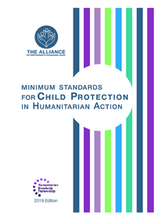The 2012 Minimum Standards for Child Protection in Humanitarian Action (CPMS) were formulated between January 2011 and September 2012 by the Child Protection Working Group (CPWG), an inter-agency working group composed of child protection practitioners, other humanitarians, academics, and policy makers. Altogether, over 400 individuals from 30 agencies and 40 countries around the world contributed to the development of the standards. The standards set out a common agreement on what needs to be achieved in order for child protection in humanitarian settings to be of adequate quality.
Years of implementing the CPMS in diverse settings revealed the need for a more user-friendly version of the Standards that would reflect recent sector learning and evidence; improve guidance on prevention, gender and age inclusion, and other cross-cutting themes; and promote applicability to a broader range of humanitarian contexts. Therefore, the Standards were updated in 2019 through a two-year revision process. The CPMS revision benefitted from the inputs of 1900 people across six continents. The CPMS WG encourages you to review early drafts of the CPMS as well as materials related to the revision process and the 2019 launch in Geneva, Switzerland.
These standards are grounded in the Sphere Handbook, a universal guide and reference developed on the premise that all people affected by disaster or conflict have a right to receive protection and assistance to ensure the basic conditions of life and dignity. Following the structure of the Sphere standards, the Minimum Standards for Child Protection in Humanitarian Action are accompanied by key actions, measurements (including indicators and targets, and guidance notes. They are intended for use by the range of actors and agencies working on child protection or related areas of humanitarian action, including those working directly with children, families and communities, planners and policy makers, coordinators, donors, academics, those working on advocacy and media/communication. This also includes the personnel of independent or multilateral organizations, security personnel, armed forces and groups.
Many of the standards emphasize the critical role of families and caregivers in protecting children at times of crisis or emergencies but also recognize the ways these emergencies can place families under intense strain and undermine their capacity to care appropriately for their children (in particular Standard on physical violence and other harmful practices and Standard 10 on Psychosocial distress and mental disorders). Specific recommendations are provided on ways of working with, and involving, caregivers in interventions to protect children, including through providing support to them in their caregiving role but also assisting them to deal with their own needs and distress. Useful guidance is also provided on addressing the care needs of children associated with armed forces or armed groups (Standard 11), and providing appropriate responses to children who are unaccompanied and separated children (Standard 13), including addressing interim care needs, identifying supportive community structures and systems, and ensuring the availability of different alternative care options.
To learn more, visit the CPMS online here.

